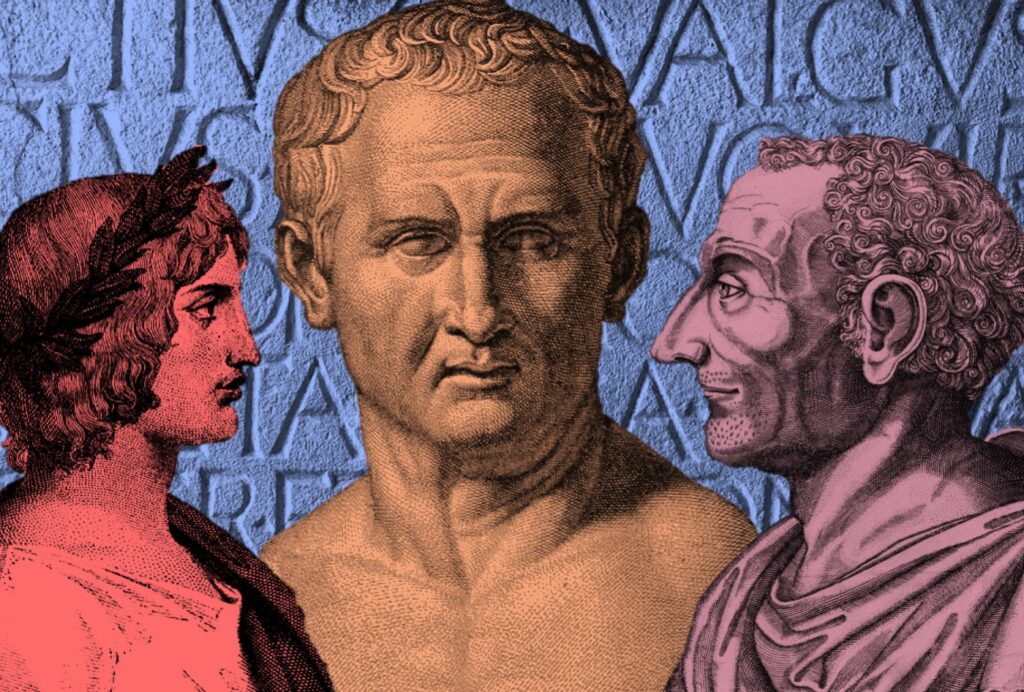Long Live Latin: The Pleasures of a Useless Language
Nicola Gardini, translated from the Italian by Todd Portnowitz
Farrar, Straus and Giroux, $26 (cloth)
Imagine the rush to leave your doomed city—the fires, the smoke, the uncertainty of where you will go, how long you will stay when you get there. In those few moments to consider your possessions, you think, “Ah, but I might have time for a book!” What do you pull from your shelves? A sacred text? Some handy and serviceable issues of Popular Mechanics? Or perhaps, like the Oxford Renaissance literature professor Nicola Gardini, you reach for Vergil’s Aeneid. “In the event of global catastrophe,” he writes in his newly translated book Long Live Latin: The Pleasures of a Useless Language, that would be “the book to salvage.” At that moment you become Aeneas, bending to carry the pater of a dying patria: your Anchises is the epic of Imperial Rome—and the legacy and detritus that comes with it.
Deeply embroiled in the culture wars, Latin remains a totemic language—attractive to religious schools, nationalists, and traditionalists alike.
Vergil, Anchises, patria. If these words are foreign to you—if you don’t know that patria is the nominative of “country” (really, “fatherland”), or that in Latin my phrase above (pater patriae) would have used the genitive of possession—it is because, some would say, we live in a degenerate age, when the classics are no longer ubiquitous and the past is no longer cherished.
Indeed Latin remains deeply embroiled in the culture wars. Conservative groups and homeschool communities have doubled down on the classical tradition, even as others—many of us classicists included—have grappled with its exclusionary and problematic reception and sought a richer contextualization of the past. (Just three months ago Christianity Today reported on “The Rise of the Bible-Teaching, Plato-Loving, Homeschool Elitists.”) Latin is no longer the bedrock of education that it used to be (along with Greek, for that matter), but all the while it has remained a totemic language—attractive to religious schools, nationalists, and traditionalists alike for its implicit cultural authority, its tradition of exclusivity, power, and prestige.
It is Latin, not Greek, after all, that is most prominently paraded as intellectual exercise or cultural badge of honor. Hundreds of thousands of precollege students study the language in the United States alone (and many of them compete for olive wreaths and bragging rights in the National Latin Exam), while ancient Greek mostly survives in seminaries and university classics departments. From this perspective, the answer to the perennial question “Why study Latin?” seems clear: it is imperial, it is canonized, and it valorizes a particular identity—the dead white men who, we are told, invented Western civilization.
The answer to the perennial question “Why study Latin?” seems clear: it is imperial, it is canonized, and it valorizes a particular identity—the dead white men who, we are told, invented Western civilization.
Of course, this is not the reason Gardini wrote his book. His primary target is the claim that Latin is useless; his impassioned prologue is called “Ode to a Useless Language.” But he is also particularly irked by the “noxious cliché” that Latin is a “dead language” because it is no longer spoken (or spoken by only very few). By his argument, no language can be dead that is still producing ideas, generating responses, and prompting emulation—from the Latin aemulatio, which can also mean “rivalry.”
His official argument for studying Latin avoids talk of utility altogether. “When we study Latin,” he writes, “we must study it for one fundamental reason: because it is the language of a civilization; because the Western world was created on its back. Because inscribed in Latin are the secrets of our deepest cultural memory, secrets that demand to be read.” But his most telling and recurring counterclaim against the tedium of utilitas is love, especially love of the beautiful. “Latin is beautiful,” he asserts emphatically—the italics are his own. “This fact undergirds all that I will be saying in these pages.” What he has written, he says, is “not a grammar book, not a history of language or literature, but an essay on the beauty of Latin.”
The problems with this approach—this ideology of the aesthetic—are legion. It fails to recognize that “civilization” is a process of selection—exclusionary by design—and that ugliness is the Janus-faced twin of beauty, the implied defect of those who don’t make the cut. Gardini’s Latin is that of an unrepentant New Critic, who searches the universe for “perfect,” “rational,” “well-ordered” verbal forms to elucidate (all these adjectives are his), without acknowledging the contexts and conflicts that have led him to seek out those forms in the first place.
There is a real-world danger to this aestheticizing attitude toward linguistic study, this appeal to “beauty” and “pleasure.”
There is a real-world danger to this aestheticizing attitude toward linguistic study, this appeal to “beauty” and “pleasure.” (Both words appear in the book at least a dozen times.) It threatens to make classics into a mystery-cult rite, through which initiates gain arcane knowledge of the nature of things (to crib some Lucretius). It distorts the marvelous range of Latin-speaking culture, flattening its richness and diversity into a one-note story about the “West.” And it suppresses analysis of the political and social conditions in which the language was used.
This kind of classicism limits history, makes ethics an entirely personal affair, and distances itself from the dirty confines of politics. Long Live Latin might have a different tone if it had been written not in the waning days of 2015 but rather in the shadow cast by Brexit, the presidency of Donald Trump, and the expropriation of the Greco-Roman past by ethnonationalists and hate groups. Indeed, though Gardini concedes in passing that studying Latin means different things in different contexts, this fact should be the first premise of his inquiry, rather than the last.
If I come down too hard on Gardini, it is because I am in many ways his fellow traveler. I too love Latin. (We both received our PhDs in classics from New York University, in fact.) I am also moved by Gardini’s fine writing, and the exceptional translation from the Italian by Todd Portnowitz: the book is an elegy for a world gone-by, a lament for the secret knowledge of words. And I shared his boyhood view of Latin as a cheat-code for social class. As Gardini writes in the opening of the book, reflecting on his first encounter with Latin textbooks and their description of the Roman domus, his study of “Latin became entangled with my desire to, in a certain sense, climb the social ladder: the dream of a magnificent home.”
The book’s organizing principle is literary: it is a collection of beautiful passages, deftly mined for their stylistic differences, interwoven with biographical reflections.
This book is that study’s magnificent home. Its organizing principle is literary: it is a collection of beautiful passages, exquisitely turned out and deftly mined for their stylistic differences, interwoven with biographical reflections on Gardini’s experience with the language. In each chapter he selects texts from specific authors and shows what is special about them. The exercise will be familiar to the classically trained as that special realm of passion and pedantry, where the best demonstrate how good they are at showing how good something else is.
The authors named in chapter headings do not range far beyond the usual suspects, who are in no danger of being forgotten and would have been familiar several generations ago: Cicero and Seneca, Livy and Tacitus, Vergil and Horace, Lucretius and Ovid. All of them are male, and most were incredibly wealthy adjacents to imperial power who relied on slaves to ply their trade. Gardini is completely transparent that the Latin he chooses to write about is the literary Latin that shaped his character and the character of the works he loves—the Latin of the classical canon, restricted in both space and time, from around 200 BCE to 200 CE. He fails to paint the larger Mediterranean context, especially the influence of Greece—an omission that parallels the erasure of non-Western contributions in general. He offers, for example, the typical yet blinkered story of a Latin Renaissance centered in Italy and moving slowly northward, discounting the cultural importance and contribution of the Byzantine Empire and the Islamic world.
The authors covered—all men—do not range far beyond the usual suspects, most of whom were incredibly wealthy adjacents to imperial power and relied on slaves to ply their trade.
The temporal restriction is telling, too. Unlike scholarly work that has sought to expand the bounds of the past, this book largely conveys a curious nostalgia—a paean to a cultural pattern created by the Renaissance, written by a professor of Renaissance literature, yet with very little of the Renaissance in it. (When Petrarch does appear in passing, Gardini’s fondness for him shines through.) The logic of this structure is partly biographical and partly aesthetic. The chapter on the latest author, St. Augustine, is introduced in the following way: “In high school, we hardly touched on Christian Latin—too late in the game, too bland. And yet, in the right hands, it too can be beautiful.”
The book shines brightest when his exhortations get you to read the words aloud, to will them back into the world, as he did for me with his evocation of Vergil’s Eclogues, finding that space between poetic verse and magic spell that is at the heart of Roman literary life. His selections of passages are worth the cover price of the book alone, especially in his chapters on Propertius, Juvenal, and Horace. Gardini makes you want to turn back to Seneca’s letters, or to marvel at the novels of Apuleius and Petronius again, if not for the first time. In this vein, he is movingly clear on the formal achievements of Lucretius, and equally powerful in his rumination on semantic shifts from Latin cura (“concern, dedication”) to English care. “The most ancient words in our language,” he writes, “are like haunted houses.”
However historical his material may be, Gardini seems persistently disinterested in history and politics.
Occasionally he goes too far, as when he claims that “Latin is the language of the relationship between the one and the many” and that “to speak of ‘Latin’ is first and foremost to speak of a complete dedication to organizing one’s words in a profound and measured discourse.” Enjoying this book does not require signing on to this definition, but it does require overlooking certain things—especially a richer sense of history. However historical his material may be, Gardini seems persistently disinterested in history and politics. He attempts to link the beautiful to the political earlier on when he writes, “Beauty is the face of freedom. What all totalitarian regimes have most strikingly in common is their ugliness.” Yet claims of “beauty” and “truth” were central to the discourses of fascism in the twentieth century. His avoidance of this fact is either incredible naiveté or willful denial.
This aestheticism becomes especially hard to take when he turns to Caesar, whose famously dry prose is held up as the epitome of “rationalism and pragmatism.” He promises not to dwell on Caesar’s great “ideological and propagandistic value.” Similarly, he calls Vergil’s epic “written evidence of an entire civilization—nothing short of a new gospel,” with hardly anything added on the century of death that preceded it or the scale of human suffering occluded by its tale. Form, here as elsewhere in the book, trumps content: “Vergil’s enduring success is owed first of all to the beauty of his language.” Likewise troubling is the briefest nod to the troubles that attended Tacitus’s imperial life (and conditioned his harsh indirectness) or the wealth, class, and power that made Seneca’s stoicism possible. In reading Livy, his uncritical tale of Lucretia’s rape is no surprise given his silence on Roman misogyny and its inheritance through the canon.
The beauty of Gardini’s phrases almost obscures a need to prove that the author is speaking the truth.
Of his textual explications, his section on Cicero may be the least convincing. The clear and instructive tour through Ciceronian passages moves between pellucid comments on syntax and quite passionate flights of fancy: “under Cicero’s direction, Latin takes the stage as a language of truth and justice.” As with Cicero’s own writing, the beauty of Gardini’s phrases almost obscures a need to prove that the author is speaking the truth. Such is the Ciceronian desire and ability to recast the world through the word, rather than deigning to make words faithfully represent it.
Gardini sings the praises of Western civilization, then, without acknowledging that this also includes imperial, colonial, and enslaving misogynists. The implicit requirement for appreciating the aesthetic beauty Gardini so admires is ignoring that literature is a political discourse—and that the canon may be complicit in history rather than merely a product of it.
We need to look to classics more critically to understand how easy it is to use what remains of Roman and Greek culture as shackles rather than means of liberation.
In the time that has passed since Gardini wrote the Italian edition of this book, we have learned a lot about what people do with Latin—who studies it, and why. In her recent book Not All Dead White Men: Classics and Misogyny in the Digital Age (2018), for example, Donna Zuckerberg tracks the alt-right’s appropriation of the classics, from the use of classical texts among Men’s Rights Activists to the superficial use of Ovid as inspiration for pickup artists. “O tempora! O mores!” we cry with Cicero upon seeing classics used by hate groups. Scholars such as Curtis Dozier (with his Pharos project) and Sarah Bond (with her tireless public outreach) have worked alongside mainstream authors such as Myke Cole to record and expose these misunderstandings and misuses of the past.
But the fact remains that classics has been a force of imperialism, classism, racism, and colonialism since its inception. (The historian Rebecca Futo Kennedy has joined others such as Dorothy Kim in cataloguing this long legacy.) We need to look to the history of our discipline more critically to understand how easy it is to use what remains of Roman and Greek culture as shackles rather than means of liberation. Affiliating ourselves with Latin requires scrutinizing the world that has received and transmitted it.
All this points to something we all know but are afraid to admit: the classical humanities have failed as humanizing enterprises. Just consider the classical educations of slaveholders such as Seneca, the classical trappings of colonialism, the superficial Latin and Greek of the so-called Founding Fathers (among them, Thomas Jefferson). German Philhellenism played no small role in Nazism and twentieth-century fascism. And, really, one needs look no further than the Oxford classical education of a buffoon like Boris Johnson to recognize that “Western Civilization” has a problem.
Those who still admire the work of canon-defending may find in Gardini’s book the echo of a rallying cry. But others will find the discomfort of self-recognition. When he closes his book, Gardini claims first that Latin is a worthwhile study because it is “fun,” but also because “Latin is here to remind us that meaning is not to be taken for granted.” In the latter claim, Gardini almost seems ready to gesture beyond the narrowly aesthetic, but instead he limply insists that “achieving linguistic beauty” is “one of the highest aims of being human.” Gardini’s Latin thus ends as an aesthetic wonder: a form with some content, but which should teach us “the importance of historical distance” and that the “ancients speak for the ancients.” Perhaps these comments are a belated attempt to stave off the distortions of twentieth-century interpretation or political misuse—but it is a weak one, undone by the implicitly political gesture of the book’s championing of a very narrow and specific canon.
Gardini sings the praises of Western civilization, without acknowledging that this also includes imperial, colonial, and enslaving misogynists. His Latin is an aesthetic wonder, form without content.
For my part, I carry the Latin I have learned with me every day as a gift. The first line of Catullus’s elegy for his brother (multas per gentes et multa per aequora vectus) ran through my head as I travelled to arrange my father’s funeral; I have regularly found comfort in Seneca’s Moral Epistles, and have learned much about how life makes us all complicit from Cicero’s personal letters. These gifts have come to me through chance and privilege.
But it is not enough to learn Latin alone, to excise it from its place and time for merely personal use. It may be naïve to think we can appreciate the past’s beauty all the more after recognizing its horrors; that we can find comfort and hope in shared humanity; and that we can still learn from the imperfect past to improve our imperfect present. Yet isn’t this the very hope for fame and glory that animated Ovid to sing?
At the end of the day, we may be what we love. Love makes Latin live through Nicola Gardini, and it is certainly lively in his hands. But part of learning to love the classics is learning what they truly are. Our engagement with literature, he admits, should make us more critical of what it—and we—do in the world; how we talk about what we love is an expression of how we view ourselves. As the Roman poet Propertius warned, sine sensu vivere amantis, et levibus curis magna perire bona: “lovers live without sense / and great affairs perish because of petty concerns.”








